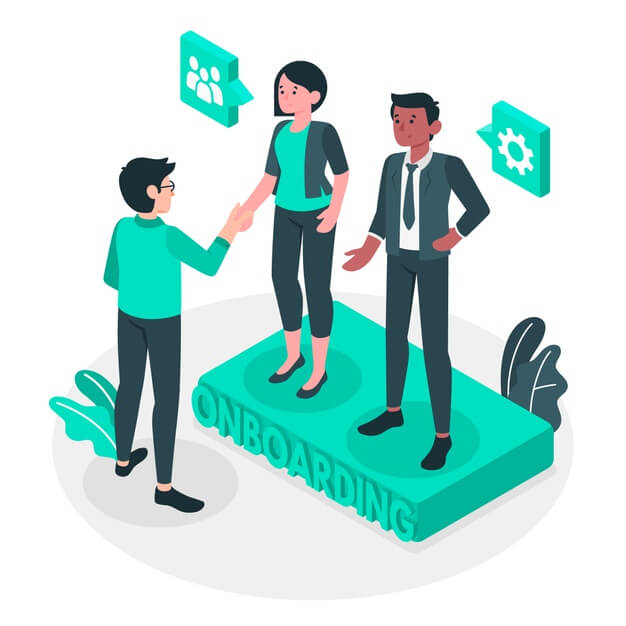According to a study, more than 50 % of employees who willingly leave their jobs do so within the first year of employment. Retention is more important than ever. What happens in the first year of employment? is something being overlooked? yes, onboarding is the key to making an employee stay or leave. Onboarding is The process of integrating a newly hired employee into an organization.
Onboarding is an important part that assists the newly hired employees in understanding their new position and job requirements. It is the process that allows them to blend in with the rest of the company. While this is primarily a formal process, there are numerous ways to make onboarding enjoyable. Companies must go far and beyond especially in today’s competitive talent scenario to create an attractive, engaging, and interesting employee experience that can retain talent.
Table of Contents
Why are the best Onboarding practices?

Employees may leave for a variety of reasons, including dissatisfaction with management, low pay, a lack of career upgrades or advancement opportunities, inadequate benefits, and so on. However, many potential problems can be avoided by preparing new hires for success.
In this article, we are going to take a look at some of the best onboarding practices that can boost employee productivity and retention.
1. Before the employee’s First Day

You’re already setting a bad example if you give new hires the silent treatment between accepting your offer and starting the job. This happens quite often, a candidate accepts a job offer, they are given a start date and then nothing happens. There is no communication whatsoever between the day they accept and the day they begin working.
In other words, new employees arrive at work on their first day unsure of what to expect. This is not how you want your new employees to feel on their first day. To get you started, here are some of the more common onboarding tasks:
- Logins for security and access keys
- Laptop, tablet, or smartphone (or BYOD registry)
- Hardware logins, password management tools, role-specific software.
- Personalized name tags, and uniforms.
- Creating an onboarding portal that new employees can access online prior to their start date is also an excellent solution.
2. First day of employee

Before an employee’s first day, a lot of preparation goes on behind the scenes, and making it work is an essential step toward creating a good early employee experience.
It is critical that the new employee understands their first day’s schedule and how orientation will go on before they arrive on day one. Ascertain that they have a desk and the necessary equipment and software to perform their duties. Make a “welcome” sign for their desk so the rest of your team knows to stop by and say hello. The agenda and orientation are the focus of the first day. Concentrate on the welcome experience and explain team ceremonies and rituals.
Almost 90 percent of new employees mentioned that they wanted to meet with their new manager on the very first day of work, and 80 percent said they expected to be introduced to coworkers on their first day to get off to a good start.
It’s a good idea to pair your new employee with a more experienced employee who can help them fully acclimate and assimilate. A buddy is ideal for answering questions that a new employee may have but does not want to bother their manager with. For example, how to use the restroom, which nearby bar has the best happy hour, and so forth.
3. Introduce new Employees to Everyone

Nothing beats a hearty welcome from the entire team, including senior executives. It is critical that when a new employee is hired, they feel connected to ALL aspects of the business. They will feel more connected to the organization if they have a basic understanding of how all of the departments interact. Being greeted by other employees (including senior executives) personifies a company.
It demonstrates to new employees that everyone is approachable. Employees are interested in their leaders as well as the colleagues with whom they will be working. According to ATD, involving senior leaders improves employee perception of the onboarding process. Even if senior leaders are unable to attend the official onboarding training sessions, they can participate. Establish a schedule for one-on-one interactions between employees and key leaders they will encounter on the job. It’s a great way to break the ice, especially for employees who are new to the company or are intimidated by their bosses.
4. Keeping their schedule Tightly Structured

There are a few advantages to planning a new hire’s entire first week or two ahead of time. For one thing, they’ll never be at a loss for what to do next. Most importantly, they will understand what they are doing. Managers and HR users can create task lists and schedules for new hires using a shared calendar or an onboarding platform. Even tasks as ambiguous as “set up your device to your preference” provide new employees with direction so they can get started instead of being confused.
Regular manager check-ins are also necessary to keep the lines of communication open so that both the employee and their manager are on the same page regarding expectations and advances. Employees and managers should establish goals and a development plan early on, and they should discuss, challenges, progress, and supplementary opportunities on a regular basis.
5. Involving different departments of the Company

Include making introductions to all departments when creating the onboarding plan. It is critical to include departments other than the new employee’s department, such as human resources, product development, marketing, and sales.
It makes things simpler for new employees to find points of contact within the company and aids in their understanding of the company’s structure.
This will help new employees to understand how their role fits into the overall bigger picture at your company. Furthermore, it can nurture critical cooperation and collaboration between departments.
6. Getting feedback from the New Employee
This is a critical step that cannot be overstated! Your new employee comes to you with fresh eyes and recent experience from other companies. You want to hear their point of view and thoughts on your company, how it processes, and everything else they’ve observed during their onboarding process. This can be the most valuable information you can get, so don’t pass it up.
According to a recent poll, roughly 40% of employees believe that when executives reject their ideas without considering them, they lack motivation. Having an active workforce is one of the benefits of listening to your employees.
The new employees are not going to tell you something bad about your company on their first day. However, if you leave open channels for honest feedback, employees will be more likely to present solutions to problems you may not even be aware of. The onboarding process provides an opportunity for your entire organization to benefit from a new perspective. Don’t be afraid to ask new employees what they like and dislike about their jobs so far, perhaps through an informal survey. If you act on their feedback, new hires will feel appreciated, and you will have made improvements as a result. That’s a win-win situation.
Conclusion
Onboarding is an important process not only for employees but also for the company to benefit in the long term. As long as the employees feel appreciated they will try to do their best for the company. Check out our article on HR Statistics to get more insights on Onboarding Practices across global organizations!






